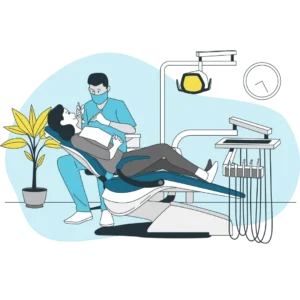If you’re running a franchise, chances are you’ve got a strong brand name—but that alone isn’t enough to fill your sales pipeline.
Whether you’re launching in a new city or trying to dominate your local market, paid advertising gives you the power to get in front of the right people, fast.
Platforms like Google Ads and Meta (Facebook + Instagram) offer laser-focused targeting, powerful data, and scalable results—exactly what franchise businesses need.
In fact, according to Statista, U.S. advertisers spent over $175 billion on digital advertising in 2024, and much of that was driven by local service businesses and franchises aiming to reach nearby customers.
A study by BrightLocal found that 93% of consumers used online search to find a local business in the past year, and more than 60% clicked on a paid ad if it matched their query.
So how do you turn paid ads into real ROI for your franchise? In this guide, we’ll break it all down—from platform choices and campaign structure to real-world best practices and conversion tips. Let’s get started.
Why Paid Advertising is Crucial for Franchise Growth
For franchise businesses, visibility is everything. You might have an amazing product or service, but if your locations aren’t showing up where your customers are looking—especially online—you’re losing sales to competitors.
That’s where paid advertising comes in. Whether it’s Google Search Ads that target people actively looking for your service, or Meta Ads that build awareness and retarget website visitors, digital advertising gives franchises an edge. It’s fast, scalable, and most importantly—measurable.
In fact, Google Ads drives an average ROI of 200%—meaning for every $1 spent, businesses earn $2 in return (WordStream). And when it comes to franchises specifically, Franchise Update Media reports that franchise systems that invest in digital advertising see 20–40% faster location-level growth compared to those that rely on organic or traditional media alone.
What makes paid ads even more valuable for franchises is control and flexibility. You can:
- Launch ads at the corporate level to drive brand-wide awareness
- Run local campaigns for individual franchisees
- Test offers or promotions by region and scale what works
Plus, with tools like location extensions in Google Ads and Meta’s advanced geo-targeting, you can ensure your budget is only going toward your ideal audience—whether that’s local shoppers, B2B leads, or people who’ve visited your website.
In short: if you’re not investing in PPC, you’re leaving growth on the table.
Understanding the Paid Ad Platforms
Not all paid ads are created equal. For franchises, the key to success is knowing which platforms to use and how to use them effectively. Let’s break down the major players.
🔍 Google Ads (Search, Display, Performance Max)
When someone types “plumber near me” or “best gym in [city],” Google Search Ads are what show up at the top. These ads capture high-intent traffic—people who are actively looking to buy or book.
For franchises, Google Ads is a goldmine. You can:
- Target by city, ZIP code, or radius around each location
- Use ad extensions to show phone numbers, hours, or maps
- Run Performance Max campaigns to cover Search, Display, YouTube, and more with smart automation
According to Google, over 90% of consumers say they discovered new businesses through Google.
📱 Meta Ads (Facebook + Instagram)
Meta’s strength lies in visual storytelling and audience targeting. Whether it’s an awareness ad for your brand or a limited-time offer for a single location, Meta lets you:
- Retarget visitors who’ve been to your website
- Target by location, interest, behavior, and even lookalikes
- Run ads on Facebook, Instagram, Messenger, and Audience Network
This platform is ideal for top- and mid-funnel engagement. According to Meta’s data, over 60% of Instagram users say they discover new products or services on the platform.
🎥 YouTube, LinkedIn & TikTok
These platforms work best when used strategically:
- YouTube Ads: Great for how-to content, testimonials, and branding
- LinkedIn Ads: Best for B2B franchises or corporate recruiting
- TikTok Ads: Emerging goldmine for QSR, fitness, beauty, and youth-focused brands
You don’t need to use all of them—just the ones that align with your franchise’s audience and goals.
Structuring Campaigns for Franchises
One of the biggest mistakes franchises make with paid ads? Running a one-size-fits-all campaign. What works for one location might flop in another. That’s why campaign structure is so important—it allows you to customize your strategy, control budgets, and get better results across the board.
🏢 National vs. Local Campaigns
- National Campaigns (managed by HQ): Great for brand awareness, seasonal promotions, or product launches that apply to every franchise location. Think big, consistent messaging.
- Local Campaigns (individual franchisee or local team): Designed to drive foot traffic, calls, or leads to a specific location. These campaigns use localized keywords, radius targeting, and city-specific offers.
Structuring your PPC campaigns by location isn’t just about ads—it’s a core part of your overall franchise marketing strategy.
The way you allocate budget, align messaging, and segment performance by region plays a big role in brand consistency and lead generation across all franchise locations.
📍 Geo-Targeting Done Right
Targeting by ZIP code, city, or even a 5-mile radius ensures your ads are showing only where they matter. For example:
- A gym franchise in Toronto can run ads within a 10 km radius
- A plumbing service franchise can exclude overlapping service areas to reduce CPC
You can even use Google’s location extensions to show the nearest franchise directly in the search ad with a map and call button. This not only improves CTR but also builds trust with searchers.
💰 Budget Allocation Tips
If you’re managing campaigns for multiple franchise locations:
- Start with a base budget per location (e.g., $500–$1,000/month)
- Adjust spend based on population, competition, and performance
- Use automated bidding strategies (like Maximize Conversions or Target ROAS) once you’ve gathered enough data
Franchise Update Media suggests that franchises see up to 25% lower CPA when campaigns are structured and budgeted at the location level.
In short: treat each franchise like its own small business inside a larger brand. The more you localize and organize your campaigns, the more impact—and ROI—you’ll see.
The Power of Local PPC: Franchise Location Targeting
When someone searches for “Mexican restaurant near me” or “moving company in Vaughan,” they’re not looking for a brand—they’re looking for a nearby solution. This is exactly why local PPC is a franchise’s secret weapon.
Local PPC allows you to zero in on potential customers who are ready to act, based on their location, intent, and behavior.
📍 Use Local Keywords That Convert
People search differently when looking for local services. Instead of “fitness programs,” they search for “fitness center in Calgary.” That’s why it’s essential to include:
- City names
- Neighborhoods or boroughs
- “Near me” variations
Tools like Google Keyword Planner or SEMrush can help you discover which local phrases people are actually using.
🗺️ Use Google’s Location Extensions
If your franchise has multiple locations, using location extensions in Google Ads is a no-brainer. These pull in your Google Business Profile (GBP) info and show:
- The exact location on a map
- Business hours
- A “call” button on mobile
According to Google, ads with location extensions see a 10–15% boost in CTR on average.
🔄 Leverage Dynamic Search Ads (DSAs)
DSAs are powerful for franchises with location-specific pages. Google automatically matches your site content with a user’s query—for example, it may show a Toronto-specific landing page to someone searching for services in Toronto.
This saves time and increases relevance without needing dozens of individual keyword sets.
Local PPC isn’t just about showing up—it’s about showing up at the right time in the right place. When done right, it becomes one of the most cost-efficient ways to drive traffic and sales to your franchise locations.
Best Practices for Ad Creatives & Messaging
It’s easy to fall into the trap of using the same generic ad across all locations.
But when it comes to PPC for franchises, creative relevance matters just as much as targeting. A well-crafted, local-focused ad can drive significantly better engagement and conversions.
Here’s how to get it right:
🧠 Tailor Creative by Location
Even if your offer is the same nationwide, personalize your ads to each location’s:
- City name (“Free Consultation at Our Calgary Location”)
- Local culture or events (“Back-to-School Special – Toronto Only!”)
- Operating hours or services (“Now Offering Same-Day Delivery in Edmonton!”)
Localized messaging can increase ad engagement by up to 50%, according to Think with Google.
🎯 Match CTA to Customer Intent
Every ad should answer one question: “What should I do next?”
- High-intent searches (e.g., “book now,” “get a free quote”)
- Awareness-level ads (e.g., “learn more,” “view services”)
- Promo-focused campaigns (“claim your discount,” “schedule your free demo”)
Use A/B testing to compare CTAs and headline variations. Often, small changes lead to big performance jumps.
📸 Visuals That Convert
On Meta Ads, imagery is everything. Use:
- Clean, bright visuals with real franchise locations (avoid stock photos when possible)
- Faces and local landmarks to build trust
- Branded colors and logos for consistency
Video ads tend to outperform static ones. In fact, Meta reports that video drives 5x higher engagement than image-only ads.
📝 Keep Messaging Brand-Consistent
You want each ad to feel local—but not off-brand. Always follow your franchise’s visual guidelines, tone of voice, and core value messaging.
Consistency builds trust. Relevance drives clicks. Combine both, and your ad creative becomes a conversion engine.
Tracking, Reporting, and KPIs
You can’t improve what you don’t measure—especially in paid advertising. Whether you’re running a single franchise or managing 50+ locations, having clear KPIs and transparent reporting makes all the difference.
📊 Core KPIs Every Franchise Should Track
These are the metrics that tell you whether your campaigns are working:
- CTR (Click-Through Rate): Measures how engaging your ad is
- CPC (Cost Per Click): Helps you monitor budget efficiency
- CPA (Cost Per Acquisition): The true cost of getting a lead or customer
- ROAS (Return on Ad Spend): The ultimate performance metric—how much you earn for every dollar spent
- Conversion Rate: % of clicks that result in a lead, purchase, or booking
According to a WordStream benchmark report, the average CPA for Google Ads across industries is around $48.96, but localized service campaigns often perform better when optimized.
🛠️ Use Google Analytics 4 + UTMs
Make sure each campaign includes UTM parameters, so you can track where traffic is coming from. With Google Analytics 4 (GA4), you can monitor:
- Engagement by location
- Which landing pages convert best
- Source/medium breakdown by channel (Google, Meta, email, etc.)
For multi-location franchises, GA4’s property filtering and custom dashboards can simplify reporting.
📈 Location-Level Reporting
If you’re managing campaigns for multiple franchisees, consider:
- Using Google Data Studio for custom live dashboards
- Automating weekly or monthly reports by location
- Segmenting performance by region or ad group
While PPC delivers fast results, it’s also important to track how it complements your long-term efforts like SEO for franchise growth.
Monitoring organic traffic alongside paid performance can help you identify which locations are gaining momentum from search visibility—and which need more investment.
The synergy between SEO and PPC often leads to lower overall cost per acquisition and stronger local brand presence.
Common Mistakes to Avoid
Even with the best intentions, franchise advertisers can fall into traps that burn budget and kill performance.
Here are some of the most common mistakes we see—and how to avoid them.
🚫 Running National-Only Campaigns
Some franchises rely entirely on corporate-run national ads.
While brand awareness is important, these campaigns often miss the mark at the local level.
If your franchise locations aren’t getting visibility in their specific service area, you’re leaving money on the table.
Fix: Always combine national campaigns with geo-targeted local ads tailored to each region or location.
📍 Ignoring Location-Specific Targeting
Serving the same ad to users in Toronto and Vancouver makes no sense—especially if only one of those cities has a physical location.
Fix: Use radius or ZIP/postal code targeting to serve ads only where your franchises operate.
Tools like Google’s location extensions and Meta’s local awareness ads make this easy.
🧪 Skipping Testing
Many franchises “set and forget” their ads. But without testing, you never know what’s really working.
Fix: A/B test headlines, descriptions, CTAs, visuals, and even landing pages. Meta reports that advertisers who run A/B tests see up to 21% better performance.
📉 No Lead Tracking System
Leads that aren’t tracked can’t be followed up—and that means lost revenue.
Fix: Use call tracking tools, form submission tracking, and conversion pixels on every campaign. Better yet, integrate it with your CRM.
Avoiding these mistakes will save you time, money, and headaches—and set the foundation for a scalable franchise PPC strategy.
Real-World Example: How a Moving Franchise Increased Leads by 143% with Local PPC
Let’s look at a real-world case to tie everything together.
🛠️ The Setup
A growing Canadian moving franchise with 10+ locations across Ontario wanted to boost lead generation through paid ads.
Previously, they relied on a single, corporate-level campaign that directed users to the brand’s homepage—no location-specific content, no geo-targeting.
They partnered with Macro Digital to restructure and localize their advertising strategy.
🎯 What We Did
- Created individual campaigns for each franchise location using Google Ads and Meta Ads
- Targeted keywords like “movers in Vaughan,” “local movers near me,” and “moving companies Toronto”
- Built dedicated landing pages for each service area with strong calls to action
- Used location extensions and call tracking for every ad group
- Ran A/B tests for ad copy and CTA buttons across locations
📈 The Results (Over 90 Days)
- 143% increase in qualified leads
- 38% lower cost per acquisition (CPA)
- 6.4% average CTR across Google Ads (industry benchmark is ~3%)
- Meta video ads outperformed image ads by 3.2x in engagement
- Individual franchisees received location-specific reports via live dashboards
💬 Client Feedback
“Once we localized our Google Ads and created pages for each of our moving locations, the results were almost immediate. We stopped wasting ad spend on irrelevant clicks and started getting more calls than ever.”
— Franchise Owner, Let’s Get Moving
This example shows that when PPC is structured, targeted, and localized properly—it works. And it scales, too.
Final Thoughts + Call to Action
Paid advertising doesn’t have to be complicated—but it does have to be strategic.
For franchises, it’s not just about turning on some Google or Meta Ads and hoping for leads.
It’s about understanding your audience, customizing by location, testing what works, and tracking everything.
The truth is, most franchise systems are still stuck using outdated marketing tactics or centralized ad campaigns that ignore local intent. That’s where the opportunity lies.
When you implement localized PPC strategies—using city-specific targeting, strong creatives, smart landing pages, and clear reporting—you unlock consistent, scalable growth for every franchise location.
At Macro Digital, we specialize in helping franchise businesses like yours get the most out of their advertising spend.
Whether you’re managing 2 locations or 200, we’ll help you build a high-converting ad strategy that brings in more calls, more bookings, and more ROI.
Looking to build long-term visibility alongside your paid campaigns? At Macro Digital, we also offer franchise SEO services to help you rank locally, boost organic traffic, and dominate your market—location by location.




